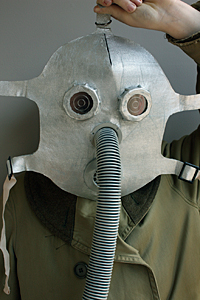
Allison Smith, “Untitled,” from “Needle Work,” 2009. Archival inkjet prints on exhibition fiber paper, 22 x 16”. Courtesy of the artist.
Allison Smith creates large-scale multimedia installations that critically engage popular forms of historical re-enactment — including sculpture, fabrics, ceramics and other traditional crafts — to redo, restage and refigure our sense of collective memory.
Frequently drawing on “living history” museums, battlegrounds and, most recently, the Internet, Smith explores notions of gender, culture and authenticity through craft and performance and the connections of both to war, violence and the construction of national identity.
Opening Friday, Feb. 5, the Mildred Lane Kemper Art Museum will showcase the artist’s most recent project, “Allison Smith: Needle Work.” The installation centers on the re-creation of European and American gas masks from World War I and World War II.
Appearing crudely fashioned from textiles such as canvas and twill tape as opposed to the more familiar industrial black rubber, these early masks — which Smith first encountered while visiting the Musée de l’Armée in Paris — struck her as meticulously, even lovingly, crafted, yet also functionally inadequate to their task.
In preparing her replicas, Smith studied the history and evolution of gas masks, often sketching from primary sources or using a cell phone to take photographs. She also scoured the Web for archival images, many of which (like the cell phone photos) proved blurry, pixelated or otherwise difficult to decipher, leaving the artist to guess at fabrics and construction details.
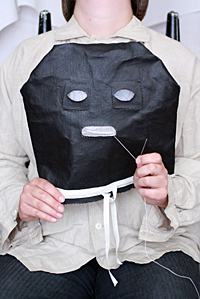
But this sense of approximation is central to Smith’s project, underscoring the unreliability of historical memory as well as the ultimate impossibility of “authentic” reproduction. Indeed, the gap between artifact and reproduction reinforces Smith’s conception of the mask as both uniform and costume, at once signifying the invisibility of the individual and the freedom to not “be oneself” at moments of one’s choosing.
This sense of performance is further emphasized by a series of staged photographs in which masks are worn, held or otherwise positioned as props, variously evoking survival, cruelty, modesty, camouflage and disguise. For Smith, the very activity of making masks is itself a performative gesture. One striking photo shows hands in the act of sewing a mask. Others depict finished masks juxtaposed with the archival images upon which they are based.
Representing another tradition of wartime needlework are four large silk parachutes — printed by Washington University’s Island Press — suspended from the museum ceiling. Inspired by World War II-era stories of women creating wedding dresses from surplus parachutes, these works present a luxurious and perhaps feminine counterpoint to other aspects of war “matériel”.
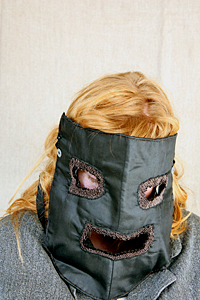
Smith developed “Needle Work” in fall 2009, while serving as the inaugural Henry L. and Natalie E. Freund Visiting Artist in Washington University’s Sam Fox School of Design & Visual Arts. During a series of campus visits, Smith also participated in the interdisciplinary studio “Past Perfect, Present Tense,” which investigated the use of historical research as a strategy within contemporary artistic practice. The studio was led by Lauren Adams, assistant professor of painting in the Sam Fox School, who also serves as curator for the exhibition.
Support for “Allison Smith: Needle Work” was provided by Bunny and Charles Burson, the Henry L. and Natalie E. Freund Art Endowment Fund, the Sam Fox School’s College and Graduate School of Art, and members of the Mildred Lane Kemper Art Museum.
CATALOG
A fully illustrated color catalog will accompany the exhibition. The catalog includes an essay by Wendy Vogel and interviews with both Smith and Adams.
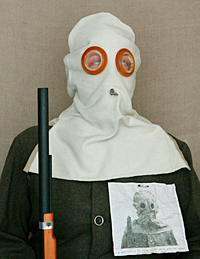
ALLISON SMITH
Smith is an assistant professor of sculpture at the California College of the Arts in San Francisco.
She has exhibited in venues throughout the United States and abroad, including the Palais de Tokyo in Paris; the Massachusetts Museum of Contemporary Art in North Adams; the Andy Warhol Museum in Pittsburgh; the Arario Gallery in Cheonan, South Korea; and the P.S.1 Contemporary Art Center in Long Island City, New York.
In 1999, she earned a master’s of fine arts from the Yale University School of Art, and, in 1999–2000, she participated in the Whitney Museum of American Art Independent Study Program.
MILDRED LANE KEMPER ART MUSEUM
The Mildred Lane Kemper Art Museum, part of Washington University’s Sam Fox School of Design & Visual Arts, is committed to furthering critical thinking and visual literacy through a vital program of exhibitions, publications and accompanying events. The museum dates back to 1881, making it the oldest art museum west of the Mississippi River. Today, it boasts one of the finest university collections in the United States.
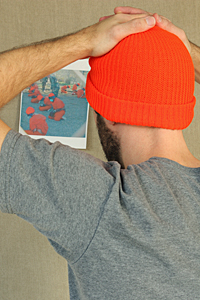
“Allison Smith: Needle Work” will open with a reception at 7 p.m. Friday, Feb. 5, and remain on view through April 19. In addition, Smith will lecture on her work at 6:30 p.m. Monday, Feb. 8, in Steinberg Auditorium.
Both the reception and the lecture are free and open to the public.
The Kemper Art Museum is located immediately adjacent to Steinberg Hall on Washington University’s Danforth Campus, near the intersection of Skinker and Forsyth boulevards. Regular hours are 11 a.m.-6 p.m. Mondays, Wednesdays and Thursdays; 11 a.m.-8 p.m. Fridays; and 11 a.m.-6 p.m. Saturdays and Sundays. The museum is closed Tuesdays.
For more information, call (314) 935-4523 or visit kemperartmuseum.wustl.edu.
|
WHO: Mildred Lane Kemper Art Museum. WHAT: Exhibition, “Allison Smith: Needle Work.” WHEN: Feb. 5 to April 19. Opening reception 7-9 p.m. Friday, Feb. 5. WHERE: Mildred Lane Kemper Art Museum, Washington University in St. Louis, near the intersection of Forsyth and Skinker boulevards. HOURS: 11 a.m.-6 p.m. Monday, Wednesday and Thursdays; 11 a.m.-8 p.m. Fridays; 11 a.m.-6 p.m. Saturdays and Sundays. Closed Tuesdays. COST: Free and open to the public. INFORMATION: (314) 935-4523 or kemperartmuseum.wustl.edu.
|